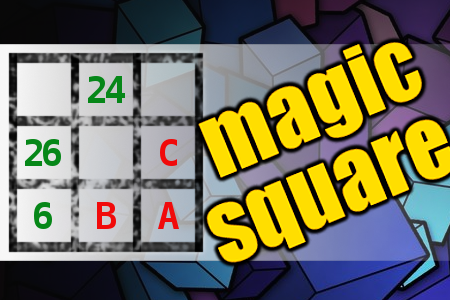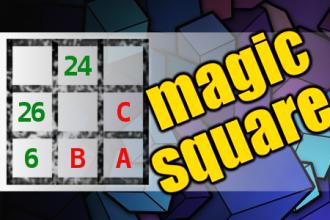MAGIC SQUARE: Calculate A*B-C
The aim is to place the some numbers from the list (6, 7, 8, 24, 25, 26, 64, 65, 66) into the empty squares and squares marked with A, B an C. Sum of each row and column should be equal. All the numbers of the magic square must be different. Find values for A, B, and C. Solution is A*B-C.Correct answers: 9
The first user who solved this task is Nasrin 24 T.
#brainteasers #math #magicsquare

A man and his wife received a...
A man and his wife received a letter from their daughter who went to study overseas:
My beloved Parents, I miss you so much. I don’t know when I’m coming home, but it seems not anytime soon. It breaks my heart to think that by the time I get back you’ll be too old. So enclosed you will find a bottle of a potion I have invented. It will make you young, so when I return you’ll be the same age as I left you.
NOTE: “Please take only one drop”
So they opened the envelope and in it there is a bottle with a red potion. The husband looks at the wife and says: “You go first.”
So the wife opens the bottle and takes a drop, there after the husband follows. Indeed they do turn 5 years younger.
Years later the daughter returns home to find her mother young and beautiful, carrying a baby on her back.
The mother proceeds to tell her daughter how the potion worked and made her look young.
The daughter is delighted and asks about her father.
“Your father? Hmmm, my child, your father was so jealous that I was young and beautiful so he drank the whole bottle.”
“So where is he?”
“Oh, that’s him I have on my back."
My beloved Parents, I miss you so much. I don’t know when I’m coming home, but it seems not anytime soon. It breaks my heart to think that by the time I get back you’ll be too old. So enclosed you will find a bottle of a potion I have invented. It will make you young, so when I return you’ll be the same age as I left you.
NOTE: “Please take only one drop”
So they opened the envelope and in it there is a bottle with a red potion. The husband looks at the wife and says: “You go first.”
So the wife opens the bottle and takes a drop, there after the husband follows. Indeed they do turn 5 years younger.
Years later the daughter returns home to find her mother young and beautiful, carrying a baby on her back.
The mother proceeds to tell her daughter how the potion worked and made her look young.
The daughter is delighted and asks about her father.
“Your father? Hmmm, my child, your father was so jealous that I was young and beautiful so he drank the whole bottle.”
“So where is he?”
“Oh, that’s him I have on my back."

